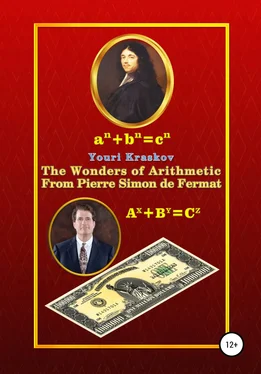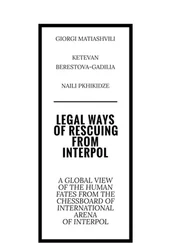Parity of a sum or difference two power number a nand b n
If ‹a› < ‹b› then ‹a n± b n› = ‹a n›. If ‹a› = ‹b› = x then
only for even n:
‹a n– b n› = ‹a – b›+ ‹a + b›+ x(n – 2) + ‹n› – 1
‹a n+ b n› = xn + 1
only for odd n:
‹a n± b n› = ‹a ± b› + x(n – 1)
When natural numbers multiplying, their parities are added up
‹ab› = ‹a› + ‹b›
When natural numbers dividing, their parities are subtracted
‹a : b› = ‹a› – ‹b›
When raising number to the power, its parity is multiplied
‹a b› = ‹a› × b
When extracting the root in number, its parity is divided
‹ b√a› = ‹a› : b
To solve equations with many unknowns in integers, an approach is often used when one more equation is added to the original equation and the solution to the original is sought in a system of two equations. We call this second equation the key formula. Until now due to its simplicity, this method did not stand out from other methods, however we will show here how effective it is and clearly deserves special attention. First of all, we note an important feature of the method, which is that:
Key formula cannot be other as derived from the original equation .
If this feature of the method is not taken into account i.e. add to the original equation some other one, then in this case, instead of solving the original equation we will get only a result indicating the compatibility of these two equations. In particular, we can obtain not all solutions of the original equation, but only those that are limited by the second equation.
In the case when the second equation is derived from the initial one, the result will be exhaustive i.e. either all solutions or insolvability in integers of the original equation. For example, we take equation z 3= x 2+ y 2. To find all its solutions we proceed from the assumption that a prerequisite (key formula) should be z = a 2+ b 2since the right-hand side of the original equation cannot be obtained otherwise than the product of numbers which are the sum of two squares. This is based on the fact that:
The product of numbers being the sum of two squares in all
cases gives a number also consisting the sum of two squares .
The converse is also true: if it is given a composite number being the sum of two squares then it cannot have prime factors that are not the sum of two squares. This is easily to make sure from the identity
(a 2+b 2)(c 2+d 2)=(ac+bd) 2+(ad−bc) 2=(ac−bd) 2+(ad+bc) 2
Then from (a 2+b 2)(a 2+b 2)=(aa+bb) 2+(ab−ba) 2=(a 2 −b 2) 2+(ab+ba) 2it follows that the square of a number consisting the sum of two squares, gives not two decompositions into the sum of two squares (as it should be in accordance with the identity), but only one, since (ab−ba)2= 0 what is not a natural number, otherwise any square number after adding to it zero could be formally considered the sum of two squares.
However, this is not the case since there are numbers that cannot be the sum of two squares.
As Pierre Fermat has established, such are all numbers containing at least one prime factor of type 4n − 1. Now from
a 2−b 2=c; ab+ba=2ab=d; (a 2+b 2) 2=c 2+d 2
the final solution follows:
z 3=(a 2+b 2) 3=(a 2+b 2)(c 2+d 2)=x 2+y 2
where a, b are any natural numbers and all the rest are calculated as c=a 2−b 2; d=2ab; x=ac−bd; y=ad+bc (or x=ac+bd; y=ad−bc). Thus, we have established that the original equation z 3=x 2+y 2has an infinite number of solutions in integers and for specific given numbers a, b – two solutions.
It is also clear from this example why one of the Fermat's theorems asserts that:
A prime number in the form 4n+1 and its square can be decomposed into two squares only in one way; its cube and biquadrate only in two; its quadrate-cube and cube-cube only in three etc. to infinity.
4. The Fermat’s Last Theorem
4.1. The Thorny Path to Truth
4.1.1. The FLT up to now remains unproven
The scientific world has been at first learned about the FLT after publication in 1670 of “Arithmetic” by Diophantus with Fermat’s remarks (see Pic. 3 and Pic. 96 from Appendix VI). And since then i.e. for three and a half centuries, science cannot cope with this task. Moreover, perhaps this is namely why the FLT became the object of unprecedented falsification in the history of mathematics. It is very easily to verify this since the main arguments of the FLT “proof” 1995 are well known and look as follows.
If the FLT were wrong, then there would be exist an elliptical “Frey curve” (???): y 2=x(x−a n)(x+b n) where a n+b n=c n. But Kenneth Ribet has proven that such a curve cannot be modular. Therefore, it suffices to obtain a proof of the Taniyama – Shimura conjecture, that all elliptic curves must be modular, so that it simultaneously becomes a proof of the FLT. The proof was presented in 1995 by Andrew Wiles who became the first scientist that allegedly has proven the FLT.
However, it turns out that the “Frey curve" and together with it the works of Ribet and Wiles have with the FLT nothing to do at all!!!
44And as regards the “proof” of A. Wiles the conjecture of Taniyama – Shimura, he also himself admitted 45that one needs much more to learn (naturally, from Wiles) in order to understand all of its nuances, setting forth on 130 pages (!!!) of scientific journal "Annals of Mathematics". Quite naturally that after the appearance of such exotic “proof”, scientists cannot come to their senses from such a mockery of science, the Internet is replete with all sorts of refutations, 46and there is no doubt that any generally accepted proof of the FLT still does not exist.
The special significance of the FLT is that in essence, this is one of the simple cases to addition of power numbers when only the sum of two squares can be a square and for higher powers such addition is impossible. However, according to the Waring-Hilbert theorem, any natural number (including an integer power) can be the sum of the same (or equal to a given) powers 47. And this a much more complex and no less fundamental theorem was proven much earlier than the FLT.
We also note the fact that the FLT attracts special attention not at all because this task is simple in appearance, but very difficult to solve. There are also much simpler-looking tasks, which are not only not to be solved, but also even nobody really knows how to approach them 48. The FLT especially differs from other tasks that attempts to find its solution lead to the rapid growth of new ideas, which become impulses for the development of science. However, there was so much heaped up on this path that even in very voluminous studies, all this cannot be systematized and combined. 49
Great scholars did not attach much importance to building the foundations of science apparently considering such creativity to be a purely formal matter, but centuries-old failures with the FLT proof indicate that they underestimated the significance of such studies. Now when it became clear where such an effective scientific tool as the descent method could come from, as well as other tools based on understanding the essence of number, it becomes clear why Fermat was so clearly superior to other mathematicians in arithmetic, while his opponents have long been in complete bewilderment from this obvious fact.
Читать дальше





![Theresa Cheung - The Dream Dictionary from A to Z [Revised edition] - The Ultimate A–Z to Interpret the Secrets of Your Dreams](/books/692092/theresa-cheung-the-dream-dictionary-from-a-to-z-r-thumb.webp)






